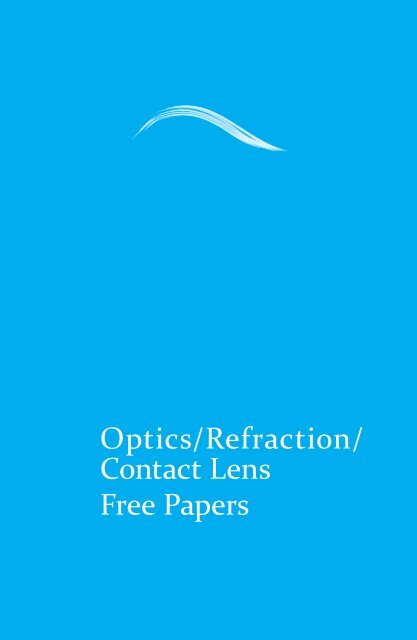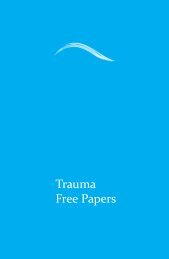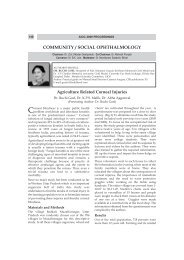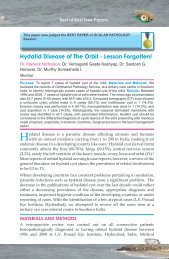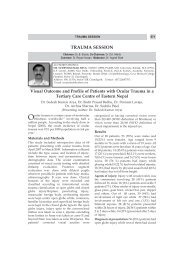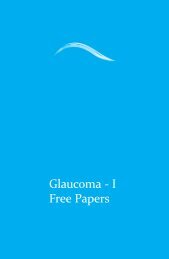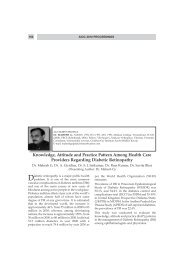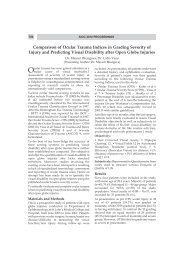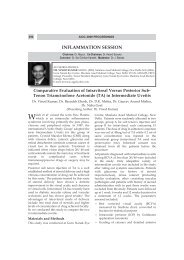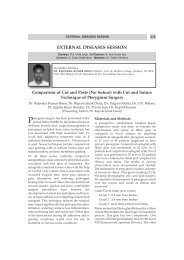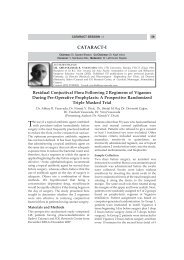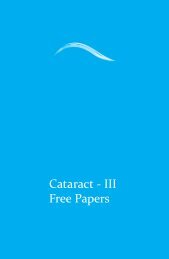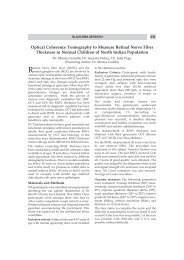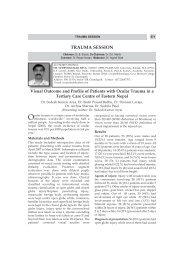Optics/Refraction/ Contact Lens Free Papers - aioseducation
Optics/Refraction/ Contact Lens Free Papers - aioseducation
Optics/Refraction/ Contact Lens Free Papers - aioseducation
You also want an ePaper? Increase the reach of your titles
YUMPU automatically turns print PDFs into web optimized ePapers that Google loves.
<strong>Optics</strong>/<strong>Refraction</strong>/<br />
<strong>Contact</strong> <strong>Lens</strong><br />
<strong>Free</strong> <strong>Papers</strong>
Contents<br />
Contents<br />
OPTICS/ REFRACTION/ CONTACT LENS<br />
Refractive Status of Eyes Treated for Retinopathy of Prematurity (ROP) with<br />
Avastin and/or Laser ....................................................................................... 403<br />
Dr. Rohan Chauhan, Dr. Alay S Banker, Dr. Usman Memon, Dr. Chatura Hutheesing,<br />
Dr. Kinnari Thakkar<br />
Accommodation Amplitude and Lag Study in Relation to Different<br />
Variables............................................................................................................ 407<br />
Prof. R Maheshwari, Dr. Ankita Phougat, Prof. R R Sukul<br />
To Study the Effect of Advanced Overnight Ortho-Keratology as a Corrective<br />
Modality for Myopia...........................................................................................411<br />
Dr. (Col) Ashish Saksena, Dr. (Maj) Shrikant Waika<br />
Evaluating The Efficacy of Orthokeratology <strong>Lens</strong>es in Myopia Regression... -<br />
.............................................................................................................................415<br />
Dr. Kirti Singh, Dr. Abhishek Goel, Dr. Ritu Arora<br />
Anterior Chamber Depth Changes in Accommodation Measured with Optical<br />
Coherence Tomography....................................................................................417<br />
Dr. Mukesh Taneja, Dr. Debarun Dutta, Dr. Tamal Chakraborty, Dr. Preetam Kumar,<br />
Dr. Virender Sangwan<br />
Role of Optical Coherance Tomography in Boston Ocular Surface Prosthesis<br />
Fitting................................................................................................................. 420<br />
Dr. Varsha Rathi, Dr. Preeji Mandathara Sudharrman, Dr. Srikanth D, Dr. Virender<br />
Sangwan S
Anton Chekhov (1860-1904):<br />
He studied medicine, but was<br />
famous for his plays. His one<br />
eye was myopic & the other<br />
hyperopic. He lost his RE due<br />
to HZO.<br />
Degas Edgar (1834-1907):<br />
A French painter, is best known for his ballerina paintings.<br />
In 1880s, when his eyesight began to fail from myopic<br />
degeneration, Degas started working with two new media<br />
(Sculpture & pastel) that did not require intense visual acuity.<br />
He was permanently blind when he was 63.<br />
Benjamin Franklin (1706-90):<br />
First invented the bifocal lens.
<strong>Optics</strong>/<strong>Refraction</strong>/<strong>Contact</strong> <strong>Lens</strong> <strong>Free</strong> <strong>Papers</strong><br />
OPTICS/ REFRACTION/ CONTACT LENS<br />
Chairman: Dr. Shreekant Kelkar B; Co-Chairman: Dr. Deepak Mehta C<br />
Convenor: Dr. Amit Tarafder; Moderator: Dr. R R Battu<br />
Dr. ROHAN RAMCHANDRA CHAUHAN: MBBS (2005), B J Medical<br />
College, Ahmedabad; DO (2007), Smt. N H L Municipal Medical College,<br />
Ahmedabad; Long Term Fellowship in Vitreo Retinal Diseases, Surgery &<br />
Intra Ocular Imflammation (2007-09). Presently, Associate Vitreo-Retinal<br />
Surgeon, Banker’s Retina Clinic & Laser Centre, Ahmedabad.<br />
E-mail: rohan_28782@yahoo.co.in; <strong>Contact</strong>: 9825203022<br />
Refractive Status of Eyes Treated for Retinopathy<br />
of Prematurity (ROP) with Avastin and/or Laser<br />
Dr. Rohan Chauhan, Dr. Alay S Banker, Dr. Usman Memon, Dr. Chatura<br />
Hutheesing, Dr. Kinnari Thakkar<br />
Retinopathy of prematurity (ROP) is a leading cause of childhood blindness<br />
worldwide. Treatment for ROP has evolved from the past from more<br />
destructive (cryo therapy) to lesser destructive (laser therapy) peripheral<br />
retinal ablation. Although these ablative treatments reduce the incidence of<br />
blindness by 25% in infants with severe disease, visual acuity post-treatment<br />
remained considerably impaired. 1<br />
The role of vascular endothelial growth factor (VEGF) in the pathogenesis of<br />
ROP has been identified. It is believed that exposure to high levels of oxygen<br />
during the neonatal period leads to obliteration of vessels. Vaso-obliteration<br />
leads to ischemia which further leads to the release of vascular growth<br />
factors and neovascularization. 2 VEGF increases permeability of vessels 3<br />
and promotes endothelial cell proliferation. 4 Transcription of VEGF mRNA<br />
increases with hypoxia and has been identified to play a vital role in retinal<br />
angiogenesis. 5 Recent studies have identified that insulin-like growth factor<br />
1 (IGF-1) plays a permissive role—in its absence VEGF is unlikely to fully<br />
stimulate vessel growth. 1 If evidence-based data supports early findings,<br />
the use of Avastin may be recommended without the need for ablative laser<br />
therapy and before retinal detachment develops.<br />
To evaluate refractive status of eyes with ROP treated with laser and/or avastin.<br />
MATERIALS AND METHODS<br />
Prospective, Nonrandomized, Non comparative case series.<br />
The procedure and the side effects of atropine were explained in details to the<br />
patient’s parents. Informed consent was obtained from the parents prior to the<br />
study with clear guidelines on the procedures and tests involved.<br />
403
69th AIOC Proceedings, Ahmedabad 2011<br />
Atropine was advised three times a day for 3 days prior to retinoscopy.<br />
Thereafter retinoscopy of the patient was performed on the fourth day. Out<br />
of 29 patients, only 1 patient had to be examined under general anaesthesia<br />
due to the hyperactivity and lack of co-operation of the patient. Based on<br />
cycloplegic retinoscopy, the patient was prescribed glasses depending on<br />
degree of refractive error. The refraction values of the patient’s parents were<br />
also noted. All patients were examined and evaluated by single optometrist.<br />
57 eyes of 29 patients were being evaluated in the study. 26 eyes were treated<br />
with laser, 26 eyes with only avastin and 5 eyes, with both laser and avastin.<br />
All patients underwent atropinized refractive evaluation under sedation.<br />
Based on cycloplegic retinoscopy with streak retinoscope, the patients were<br />
prescribed glasses depending on his/her age and degree of refractive error.<br />
RESULTS<br />
26 Avastin treated eyes at the mean age of 1 year showed a mean spherical<br />
equivalent (MSE) of -3.087 DS and -0.920 DC. 6/26 eyes were high myopic<br />
(-10.50 DS). 26 eyes in laser group at the mean age of 2 years showed a MSE of<br />
-2.058 DS and -1.00 DC. 3/26 eyes were high myopic (-13.16 DS). 5 eyes treated<br />
with laser and avastin at the mean age of 2 years showed MSE -2.30 DS and<br />
-1.00 DC.<br />
Amongst the avastin treated patients, 18/26 eyes were myopic and 7 were<br />
hyperopic with a mean spherical refractive error to be -3.087DS. 22/26 eyes<br />
were astigmatic with a mean astigmatic error of -0.920D. Amongst the laser<br />
treated patients in study, 12/26 eyes were myopic and 12 were hyperopic<br />
with a mean spherical refractive error as -2.058DS. 23/26 eyes were astigmatic<br />
with a mean astigmatic error as -1.00D. Amongst the patients treated with<br />
laser as well as avastin in study, 3/5 eyes were myopic and 2 were hyperopic<br />
with a mean spherical refractive error of -2.30 DS. 4/5 eyes were astigmatic<br />
with a mean astigmatic error of -1.00 D. Therefore myopia was seen to be the<br />
most predominant refractive error amongst all the 3 sub-groups of patients<br />
– avastin treated, laser treated as well as both, laser and avastin treated. It<br />
was found that 6/26 eyes in the avastin treated group of patients were highly<br />
myopic (that is, greater than -8.00 DS). If we exclude those highly myopic eyes<br />
from the study, the mean spherical refractive error was found to be -0.8625<br />
DS. Similarly, in the laser treated group of patients, 3/26 eyes were found to<br />
be highly myopic. On excluding those highly myopic eyes, the mean spherical<br />
refractive error of the patients treated with laser was found to be -0.609 DS.<br />
In this study, the mean age on retinoscopy of the patients treated with avastin<br />
is 1 year. Whereas the mean age on retinoscopy of the patients treated with<br />
laser photocoagulation is 2 years. As these two groups are incomparable<br />
due to the vast difference in the mean age group of the patients, for better<br />
404
<strong>Optics</strong>/<strong>Refraction</strong>/<strong>Contact</strong> <strong>Lens</strong> <strong>Free</strong> <strong>Papers</strong><br />
comparison, the patients whose age on retinoscopy was equal to or greater<br />
than 3.5 years where excluded. Thereby the mean age on retinoscopy of<br />
the patients treated with laser photocoagulation was 1 year 4 months. On<br />
excluding the above mentioned patients, the mean spherical refractive error of<br />
the laser treated patients was found to be -1.579 DS instead of -2.058 DS and the<br />
mean astigmatic error was found to be -0.96 D. The mean spherical refractive<br />
error of the avastin treated patients was found to be -3.087 DS and the mean<br />
astigmatic error was found to be -0.920 D.<br />
DISCUSSION<br />
Myopia<br />
Correlating to this, simple cross-sectional studies comparing premature with<br />
full-term infants have revealed that premature infants are more prone to<br />
development of myopia from an early age and may remain myopic later on in<br />
childhood and adolescence. This is known as myopia of prematurity, 6,7,8,9,10,11<br />
and it can continue to increase up to 2 years of age. 12,13<br />
Hypermetropia<br />
Which can be supported by a study carried out by Anne cook et al 5 which<br />
states that there is consistently less hypermetropia noted at term in premature<br />
infants, with or without ROP, when compared with full-term infants. By 3<br />
months’ corrected age, this difference is much less in those premature eyes<br />
without ROP. Eyes with ROP, however, still maintain less hypermetropia than<br />
full-term eyes by the end of 3 months’ corrected age. 15,16<br />
A second study of infants with and without ROP reported a similar prevalence<br />
of astigmatism > 1.00 D in 652 infants and in 551 infants, with all refractions<br />
during the first week of life. 17 Some studies have documented a decreasing<br />
prevalence of astigmatism between infancy and childhood in preterm<br />
infants. 18,19,20,21 In contrast, a recent study, in which 293 low birth weight (< 1701<br />
g) children were refracted at six months corrected age and again at age 10 to<br />
12 years, reported little change in astigmatism power or axis over this long<br />
period, with 75% of children showing a change in cylinder power of no more<br />
than 0.75 D.6<br />
Avastin being a new mode of treatment for ROP, not many studies regarding<br />
the refractive outcomes of ROP patients treated with avastin have been done.<br />
Hence, this study can be considered as first of its kind. This can be correlated<br />
with a study carried out by Dhawan A et al. 21 which resulted in a mean<br />
spherical equivalent of -4.71 D at follow up of 1 year after laser treatment.<br />
Myopia was seen in 80.43% of 184 eyes in this study. Another study that can be<br />
correlated is the one in which the mean spherical equivalent values obtained<br />
as -3.87 D in patients with age of 7 years or more in a study carried out by Yang<br />
405
69th AIOC Proceedings, Ahmedabad 2011<br />
CS et al. 22 A study by Yang CS et al showed that out of 60 laser treated eyes, 46<br />
eyes (77.0%) were myopic, the overall mean spherical equivalent was -3.87D.<br />
Anisometropia (>/= 1,50 D) was also noted in 14 patients (46.7%). Strabismus<br />
was present in 4 patients (30%). Davitt BV et al. 23 proved that by the age of<br />
3 years, nearly 43% of eyes treated at high risk prethreshold ROP developed<br />
astigmatism of >or= 1.00D and nearly 20% had astigmatism of >or= 2.00 D.<br />
Presence of astigmatism was not influenced by timing of treatment of acute<br />
phase ROP or by characteristics of acute phase or cicatricial ROP.<br />
Myopia was found to be the predominant refractive error in the ROP population<br />
at the clinic, irrespective of the treatment group and with no correlation with<br />
the family history of myopia.<br />
REFERENCES<br />
1. Chen J, Smith LE. Retinopathy of prematurity. Angiogenesis. 2007;10:133–40.<br />
2. Patz A. Clinical and experimental studies on retinal neovascularization.XXXIX<br />
Edward Jackson Memorial Lecture. Am J Ophthalmol. 1982;94:715–43.<br />
3. Senger DR, Galli SJ, Dvorak AM, Perruzzi CA, Harvey VS, Dvorak HF. Tumor cells<br />
secrete a vascular permeability factor that promotes accumulation of ascites fluid.<br />
Science. 1983;219:983–5.<br />
4. Leung DW, Cachianes G, Kuang WJ, Goeddel DV, Ferrara N. Vascular endothelial<br />
growth factor is a secreted angiogenic mitogen. Science. 1989;246:1306–9.<br />
5. Aiello LP, Northrup JM, Keyt BA, Takagi H, Iwamoto MA. Hypoxic regulation of<br />
vascular endothelial growth factor in retinal cells. Arch Ophthalmol. 1995;113:1538–<br />
44.<br />
6. O’Connor A, Stephenson T, Johnson A, et al. Long term ophthalmic outcome of low<br />
birth weight children with and without retinopathy of prematurity. Paediatrics.<br />
2002;109:12–8.<br />
7. Fledelius HC. Myopia of prematurity: changes during adolescence. Doc Ophthalmol<br />
Proc Series. 1981;28:63–9.<br />
8. Hungerford J, Stewart A, Hope P. Ocular sequelae of preterm birth and their<br />
relation to ultrasound evidence of cerebral damage. Br J Ophthalmol. 1986;70:463–8.<br />
9. Fledelius HC. Pre-term delivery and subsequent ocular development: a 7–10 year<br />
follow up of children screened for ROP 1982–4. Acta Ophthalmol Scand. 1996;74:297–<br />
300.<br />
10. Birge H. Myopia caused by prematurity. Trans Am Ophthalmol Soc 1955;292–8.<br />
11. Gordon RA. Donzis PB. Myopia associated with retinopathy of prematurity.<br />
Ophthalmology 1986;93:1593–8.<br />
12. Page J, Schneeweiss S, Whyte H, Harvey P. Ocular sequelae in premature infants.<br />
Paediatrics. 1993;92:787–90.<br />
13. Gallo JE, Fagerholm P. Low-grade myopia in children with regressed retinopathy<br />
of prematurity. Acta Ophthalmol 1993;71:519–23.<br />
406
<strong>Optics</strong>/<strong>Refraction</strong>/<strong>Contact</strong> <strong>Lens</strong> <strong>Free</strong> <strong>Papers</strong><br />
14. Mayer DL, Hansen RM, Moore BD, Kim S, Fulton AB. Cycloplegicrefractions in<br />
healthy children ages 1 through 48 months. Arch Ophthalmol. 2001;119:1625–8.<br />
15. Quinn G, Dobson V, Kivlin J et al. The Cryo-ROP Group.Prevalence of myopia<br />
between 3 months and 5 1⁄2 years in premature infants withand without ROP.<br />
Ophthalmology. 1998;105:1292–1300.<br />
16. Varughese S, Varghese RM, Gupta N, et al. Refractive error at birth and its relation<br />
to gestational age. Curr Eye Res. 2005;30:423–8.<br />
17. Saunders KJ, McCulloch DL, Shepherd AJ, Wilkinson AG. Emmetropisation<br />
following preterm birth. Br J Ophthalmol. 2002;86:1035–40.<br />
18. Larsson EK, Holmström GE. Development of astigmatism and anisometropia in<br />
preterm children during the first 10 years of life: a population-based study. Arch<br />
Ophthalmol. 2006;124:1608–14.<br />
19. O’Connor AR, Stephenson TJ, Johnson A, et al. Change of refractive state and eye<br />
size in children of birth weight less than 1701g. Br J Ophthalmol. 2006;90:456–60.<br />
20. Holmström G , el Azazi M, Kugelberg U. Ophthalmological long term follow up<br />
of preterm infants: a population based, prospective study of the refraction and its<br />
development. Br J Ophthalmol 1998;82:1265–71.<br />
21. Dhawan A, Dogra M, Vinekar A, Gupta A, Dutta S. Structural sequelae and<br />
refractive outcome after successful laser treatment for threshold retinopathy of<br />
prematurity. J Pediatr Ophthalmol Strabismus. 2008;45:356-61.<br />
22. Yang CS, Wang AG, Sung CS, Hsu WM, Lee FL, Lee SM. Long term visual outcomes<br />
of laser-treated threshold retinopathy of Prematurity: a study of refractive status<br />
at 7 years. Eye (Lond). 2010;24:14-20. Epub 2009 Apr 3.<br />
23. Davitt BV, Dobson V, Quinn GE, Hardy RJ, Tung B, Good WV; Early Treatment<br />
for Retinopathy of Prematurity Cooperative Group. Astigmatism in the Early<br />
Treatment of Retinopathy Of Prematurity Study: findings to 3 years of age.<br />
Ophthalmology. 2009116:332-9. Epub 2008 Dec 16.<br />
Accommodation Amplitude and Lag Study in<br />
Relation to Different Variables<br />
Prof. R Maheshwari, Dr. Ankita Phougat, Prof. R R Sukul<br />
To evaluate amplitude (AA) and lag (AL) of accommodation with respect to<br />
ametropia, emmetropia and amblyopia.<br />
To study lens thickness (LT), anterior chamber depth (ACD) and axial length<br />
(AxL) changes during accommodation.<br />
Accommodation is the process by which vertebrate eye changes refractive<br />
power to maintain a clear image (focus) of an object as its distance from eye<br />
changes. The word accommodation was given by Burrow (1841). 1 The functional<br />
significance of active accommodation is evident from the inconvenience that<br />
results from its gradual age-related loss in presbyopia, manifests earliest in<br />
407
69th AIOC Proceedings, Ahmedabad 2011<br />
hyperopes and in emmetropes at about 40 years of age, when the accommodative<br />
reserve becomes insufficient to focus on near objects. However, the loss of<br />
accommodative amplitude begins early in life 2 and progresses to about age<br />
55, when accommodation, as measured objectively, is completely lost. 3 Near<br />
work has been claimed to induce myopia and accommodation loss has been<br />
considered a risk factor for amblyopia. This study is undertaken to see the<br />
variation in accommodation with refractive errors, age and amblyopia. Also,<br />
various biometric changes with accommodation have been studied using<br />
A-scan.<br />
MATERIALS AND METHODS<br />
75 patients in the age group of 11-30yrs were included in the study after taking<br />
informed consent. The assessment of selected patients included a detailed<br />
history, general and ocular examination, including biomicroscopy and direct<br />
ophthalmoscopy. All patients underwent a wet retinoscopy followed by dry<br />
retinoscopy a week later. Emmetropes, ammetropes and amblyopes without<br />
any ocular pathology (normal anterior and posterior segments) or systemic<br />
illness presenting to us in the OPD were selected.<br />
Measurements included AA using method of spheres (MOS) and RAF rule, AL<br />
using dynamic retinoscopy; LT, ACD and AxL changes during accommodation<br />
using A-scan. Eyes were divided based on: age (11-15,15-20,20-25 and 25-30),<br />
refractive error (emmetropia, myopia4,hypermetropia4),<br />
presence or absence of amblyopia. Accommodation lag, amplitudes; LT, ACD<br />
and AxL changes during accommodation, were compared in different groups.<br />
Also, two methods of measuring accommodation i.e. the RAF rule and MOS<br />
were compared.<br />
RESULTS<br />
Mean of accommodation amplitude(AA) by RAF rule for myopes4D<br />
was 11.37D, hypermetropes 4 is 9D. Corrected low myopes showed a significantly higher<br />
amplitude of accommodation compared to emmetropes (p< 0.005) and<br />
hypermetropes (p
<strong>Optics</strong>/<strong>Refraction</strong>/<strong>Contact</strong> <strong>Lens</strong> <strong>Free</strong> <strong>Papers</strong><br />
RAF AA was 9.82. AA values by MOS were significantly lower compared to<br />
RAF rule (p
69th AIOC Proceedings, Ahmedabad 2011<br />
DISCUSSION<br />
Our study showed that AA was highest in myopes followed by emmetropes<br />
and least in hypermetropes. Similar results have been initially obtained by<br />
McBrien et al. 4 Schaeffel et al 5 have shown that refractive errors do not affect<br />
the dynamics of natural accommodation. AA is highest in myopes and lowest<br />
in hypermetropes till the age of 44yrs after that no difference exists (Lekha<br />
Mary Abraham et al). 6<br />
In regards to other methodology, AA by MOS showed lower values<br />
compared to RAF. The minus lens technique has found reduced amplitudes<br />
of accommodation compared to the far to near technique, possibly due to<br />
the apparent minification of the image; 7 the smaller image interpreted as<br />
being further away may stimulate less effort to accommodate. The plus lens<br />
technique used to neutralize the reduced accommodative effort seen with<br />
dynamic retinoscopy is thought to reduce the accommodative response<br />
to blur and simultaneously relax the subject’s accommodation during<br />
testing (Rosenfield M et al). 8 Leat and Gargon (1996) 9 reported that lags of<br />
accommodation increases with an increase in age. <strong>Lens</strong> thickness increases<br />
and anterior chamber depth decreases during accommodation for near<br />
(Matthias Bolz, Ana Prinz, Wolfgang Drexler and Oliver Findl, 2007). 10 In a<br />
study of accommodation in amblyopia (Goel et al 1981) 11 it has been observed<br />
that accommodation is considerably less in the amplyopic eye than the nonamblyopic<br />
and control eyes similar to our findings of low AA in amblyopes.<br />
Duane 12 has shown that AA falls with age but fall not significant in 10-20yr<br />
age group. Edward A. H. Mallen et al 13 reported that Axial length increased in<br />
both emmetropic and myopic subjects during short periods of accommodative<br />
stimulation. Greater transient increases in axial length were observed in<br />
myopic than in emmetropic subjects.<br />
Accommodation is highest in corrected low myopes followed by emmetropes<br />
and lowest in corrected hypermetropes. It decreases with increasing age<br />
but the decrease is not significant in 11-20yr. Amblyopes have low AA and<br />
higher AL compared to non-amblyopes. AC depth decreases while LT and<br />
AxL increases during accommodation and the increase is significantly more<br />
in myopes(especially in 10-20yr age group).<br />
REFERENCES<br />
1. Burrow.Beitr.2 Physiologieu.Physik d. menseh. Auges. Berlin, 94(1841).<br />
2. Duane A. Normal values of the accommodation at all ages. J Am Med Assoc 1912;<br />
59:1010–3; also Trans Sect Ophthalmol AMA 1912;383–91.<br />
3. Hamasaki D, Ong J, Marg E. The amplitude of accommodation in presbyopia. Am<br />
J Optom Arch Am Acad Optom 1956;33:3–14.<br />
410
<strong>Optics</strong>/<strong>Refraction</strong>/<strong>Contact</strong> <strong>Lens</strong> <strong>Free</strong> <strong>Papers</strong><br />
4. Mc Brien NA, Millodot M. Amplitude of Accommodation and Refractive Error.<br />
Invest Ophthalmol Vis Sci 1986;27:1187-90.<br />
5. Schaeffel F, Wilhelm H, Zrenner E. Inter individual variability in the dynamics of<br />
natural accommodation in humans in relation to age and refractive errors. Journal<br />
of Physiol (Lond) 1993;461:301-20.<br />
6. Lekha Mary Abhram et al. Amplitude of Accommodation and its relation to<br />
refractive errors, IJO 2005;53:105-8.<br />
7. Rosenfield M, Cohen A: Repeatability of clinical measurements of the amplitude of<br />
accommodation. Ophthal Physiol Opt 1996;16:247–9.<br />
8. Rosenfield M, Portello J, Blustein G, Jangs C: Comparison of clinical techniques to<br />
assess the near accommodative response. Optom Vis Sci 1996;73:382–8.<br />
9. Leat SJ, Gargon JL. Accommodative response in children and young adults using<br />
dynamic retinoscopy. Ophthalmic Physiol Opt 1996;16:375-84.<br />
10. Matthias Bolz, Ana Prinz, Wolfgang Drexler and oliver findl. Linear relationship of<br />
refractive and biometric lenticular changes during accommodation in emmetropic<br />
and myopic eyes. British Journal Of Ophthalmology 2007;91:360-5.<br />
11. Goel, B.S., Maheshwari, R., and Saiduzzafar, H., Subjected for publication in Indian<br />
Journal of Ophthalmology, 1981.<br />
12. Duane A., Amer. Ophtlialmol 1922;5:865.<br />
13. Edward A.H. Mallen, Priti Kashyap and Karen H. Hampson. Transient axial<br />
length change during the accommodation response in young adults. Investigative<br />
Ophthalmology and Visual Science 2006;47:1251-4.<br />
To Study the Effect of Advanced Overnight<br />
Ortho-Keratology as a Corrective Modality for<br />
Myopia<br />
Dr. (Col) Ashish Saksena, Dr. (Maj) Shrikant Waika<br />
Orthokeratology is the temporary reduction of myopia achieved by reshaping<br />
the cornea with specially designed reverse geometry gas permeable<br />
Orthokeratology shaping lenses worn during sleep. It was first introduced in<br />
1960’s when few hard contact lens wearers reported improvement in vision after<br />
removal of their lenses. Gearge Jessen created the first Orthokeratology lens<br />
design from PMMA material. The early lenses were flat fitting with frequent<br />
decentration leading to significant with the rule corneal astigmatism. These<br />
lenses were not suitable for overnight wear. A series of lenses were needed<br />
each lens flattening the cornea a small amount until the desired results were<br />
attained. This took months to years to accomplish. The advent of space-age<br />
oxygen polymers, computer assisted lathes and technological advancements<br />
in corneal measuring and mapping has made it possible to reverse myopia in<br />
a matter of hours.<br />
411
69th AIOC Proceedings, Ahmedabad 2011<br />
Hence, modern Orthokeratology is called accelerated Orthokeratology.<br />
Accelerated Orthokeratology utilises reverse geomerty lens design made of<br />
high Dk material. These can be worn overnight and do not cause induced<br />
with the rule astigmatism and result in corneal sphericalisation. Reverse<br />
geometry lenses are fitted with a base curve flatter than the central corneal<br />
curvature. This exerts a positive pressure as a result of which the central<br />
corneal epithelium is thinned out, the sagittal corneal height is decreased<br />
which shortens the length of the eye reducing the corneal power resulting in<br />
correction of myopia. And evaluation of correction of myopia by accelerated<br />
advanced overnight Orthokeratology using third generation 5 curve reverse<br />
geometry corneal reshaping lens has been carried out in this study.<br />
MATERIALS AND METHODS<br />
710 eyes of 355 patients of Myopia with or without astigmatism underwent<br />
advanced overnight Orthokeratology using third generation 5 curve reverse<br />
geometry corneal reshaping lens.<br />
Inclusion Criteria<br />
• Age group between 7yrs to 52yrs.<br />
• Myopia (Spherical equivalent) upto -7.5D.<br />
Exclusion Criteria<br />
• Corneal dystrophies.<br />
• Dry eyes.<br />
• Any other associated ocular disease.<br />
• Any ocular surgery in the past.<br />
• Any refractive procedure in the past.<br />
• Any ocular surface pathology.<br />
Pretreatment and post treatment unaided visual acuity, Objective and<br />
Subjective refraction, slit lamp examination and corneal topography findings<br />
were recorded. Orthokeratology lens was selected based on flat K on corneal<br />
topography and placed on patient’s eye. Ideal fitting was confirmed using<br />
fluoroscein staining. Orthokeratology lens was removed after 8 hours.<br />
Improvement in unaided visual acuity was recorded which was an indicator<br />
of the correction of Myopia by advanced overnight Orthokeratology over a<br />
period of 8 hours.<br />
RESULTS<br />
710 eyes of 355 patients were included in this study. The youngest patient was<br />
7 years old and the oldest 52 years. There were 88 patients in the 7-12 year age<br />
412
<strong>Optics</strong>/<strong>Refraction</strong>/<strong>Contact</strong> <strong>Lens</strong> <strong>Free</strong> <strong>Papers</strong><br />
group, 161 in the 13-20 years group and 106 in the 21-52 years group out of<br />
which 160 were males and 195 females. 300 eyes had simple myopia and 410<br />
had compound myopic astigmatism. 320 eyes had with the rule astigmatism<br />
ranging between -1.0D to -2.0D. 50 eyes had the same ranging between -2.0D to<br />
-3.0D and 10 eyes with -3.5D. 30 eyes had against the rule astigmatism varying<br />
between -0.5D to -1.0D. The spherical equivalent refraction was calculated<br />
and the effect of advanced overnight orthokeratology with 5 curve reverse<br />
geometry corneal reshaping lenses was assessed. 236 eyes with myopia<br />
(spherical equivalent) of up to -2.0D with pre-application unaided visual<br />
acuity between 6/9 to 6/18 achieved unaided vision of 6/6 after removal of<br />
the 5 curve reverse geometry orthokeratology lens after overnight wear for 7<br />
hours. These eyes had a complete reversal of myopia.<br />
Out of 266 eyes with myopia (spherical equivalent) ranging between -2.0D to<br />
-4.0D and pre-application unaided vision ranging between 6/60 to 6/24,148<br />
regained vision of 6/6 and 118 eyes a vision of 6/9 after removal of overnight<br />
applied lenses. 208 eyes in myopic range of -4.0D to -7.5D with unaided vision<br />
range 1/60 to 5/60 pre lens application achieved unaided visual range of 6/18<br />
to 6/12. There was more than 2 snellen line correction in every case. Some<br />
eyes showed improvement of upto 9 snellen lines. Statistical analysis showed<br />
that correction of myopia as reflected in improvement of visual acuity was<br />
statistically highly significant at p
69th AIOC Proceedings, Ahmedabad 2011<br />
were noticed in this study which is ongoing and will assess the safety of these<br />
lenses over a long term.<br />
Advanced overnight orthokeratology with 5 curve reverse geometry corneal<br />
reshaping lens corrects myopia rapidly and dramatically. It is very useful<br />
for patients who wish to be spectacle free to participate in contact sports<br />
like boxing or wrestling or those who work in dusty areas and cannot wear<br />
conventional contact lens. It is especially useful in professions like police,<br />
firemen and athletes. It is non-invasive and reversible and can be safely<br />
used in children unlike LASIK. The effect of orthokeratology in slowing the<br />
progression of myopia in children is also under evaluation at some centres.<br />
Orthokeratology is a viable option for correction and treatment of myopia ad<br />
should be a part of the armamentarium of all ophthalmologists.<br />
REFERENCES<br />
1. Kerns RL. Research in Orthokeratology. Part VIII: results, conclusions and<br />
discussion of techniques. J Am Optom Assoc 1978;49:308-14.<br />
2. Binder PS, May CH, Grant SC. An evaluation of Orthokeratology. Ophthalmology<br />
1980;87:729-44.<br />
3. Nichols JJ, Marsich MM, Nguyen M, et al. Overnight Orthokeratology optom Vis Sci<br />
2000;77:252-9.<br />
4. Swarbrick HA, Alharbi A. Overnight Orthokeratology induces central corneal<br />
epithelial thinning. Invest Ophthalmol Vis Sci 2001;42:S597.<br />
5. Mountford J. An analysis of the change in corneal shape and refractive error<br />
induced by accelerated orthokeratology. ICLC 1997;24:128-44.<br />
6. Lui W-O, Edwards MH. Orthokeratology in low myopia. Part 1: efficacy and<br />
predictability. Cont <strong>Lens</strong> Anterior Eye 2000;23:77-89.<br />
7. Wlodyga RJ, Bryla C. Corneal molding: the easy way. <strong>Contact</strong> <strong>Lens</strong> Spectrum<br />
1989;4:58-65.<br />
8. Johnson KL, Carney LG, Mountford JA, Collins MJ, Cluff S, Collins PK. Visual<br />
performance after overnight Orthokeratology. Cont <strong>Lens</strong> Anterior Eye. 2007;30:29-<br />
36. Epub 2007 Jan 9.<br />
9. Soni PS, Nguyen TT; XO Overnight Orthokeratology Study Group. Overnight<br />
Orthokeratology experience with XO material. Eye <strong>Contact</strong> <strong>Lens</strong>. 2006;32:39-45.<br />
10. Cheung SW, Cho P, Chui WS, Woo GC. Refractive error and visual acuity changes<br />
in Orthokeratology patients. Optom Vis Sci. 2007;84:410-6.<br />
11. Chan B, Cho P, Cheung SW Orthokeratology practice in children in a university<br />
clinic in Hong Kong. Clin Exp Optom. 2008;91453-60. Epub 2008 Mar 18.<br />
12. Walline JJ, Rah MJ, Jones LA The children’s Overnight Orthokeratology<br />
Investigation (COOKI) pilot study. Optom Vis Sci. 2004;81:407-13.<br />
13. Rah MJ, Jackson JM, Jones LA, Marsdem HJ, Bailey MD, Barr JT Overnight<br />
Orthokeratology: preliminary results of the <strong>Lens</strong>es and Overnight Orthokeratology<br />
(LOOK) stugy. Optom Vis Sci. 2002;79:598-605.<br />
414
<strong>Optics</strong>/<strong>Refraction</strong>/<strong>Contact</strong> <strong>Lens</strong> <strong>Free</strong> <strong>Papers</strong><br />
14 Chan B, Cho P, Cheung SW. Orthokeratology practice in children in a university<br />
clinic in Hong Kong. Clin Exp Optom. 2008;91:453-60. Epub 2008 Mar 18.<br />
15. Watt KG,Swarbrick HA. Trends in Microbial keratitis associated with<br />
Orthokeratology. Eye <strong>Contact</strong> <strong>Lens</strong>. 2007;33:373-7; discussion 382.<br />
16. Shehadeh-Mashaour R, Segev F, Barequet IS, Ton Y, Garzozi HJ. Orthokeratology<br />
associated microbial keratitis. Eur J Opthalmol. 2009 Jan-Feb.<br />
Evaluating The Efficacy of Orthokeratology<br />
<strong>Lens</strong>es in Myopia Regression<br />
Dr. Kirti Singh, Dr. Abhishek Goel, Dr. Ritu Arora<br />
Orthokeratology is the temporary reduction of myopia by programmed<br />
application of specially designed contact lenses which reshapes the cornea.<br />
These reverse geometry lenses are made of highly oxygen transmissible Boston<br />
XO material with Dk value exceeding 140. The flat base curve applies gentle<br />
pressure to central corneal zone, causing sphericalisation of the prolate cornea<br />
leading to reduction of myopia. Tear film meniscus behind the contact lens<br />
hydraulically redistributes epithelial cells from the centre towards periphery.<br />
A secondary curve steeper than central base curve aids centration of lens.<br />
To evaluate efficacy of overnight wear of in mild to moderate myopia and<br />
evaluate its effect if any on the corneal health.<br />
MATERIALS AND METHODS<br />
Orthokeratology lenses (OK) were used in fifteen adults with myopia ranging<br />
from 1.75 - 5.75 D. The change in refractive status was assessed over a 3 month<br />
period. Corneal changes and health was evaluated by corneal thickness,<br />
topography, endothelial cell count and tear film status. Cases of astigmatism<br />
exceeding 1.5Ds, dry eyes, prior ocular surgery and retinal pathology were<br />
excluded. Initial overnight wear was supervised and subsequently patient<br />
was allowed to use the lens on his/her own. Follow up was fortnightly for 1<br />
month and monthly for 3 months.<br />
RESULTS<br />
An unaided visual acuity improvement of 6/6 was attained in 9 cases (60%)<br />
with a prior myopia of 2.75Ds (2.0Ds-3.5Ds) after an initial 8 hours of overnight<br />
OK lens wear. The mean improvement was 5.98 lines (4-7lines). Subsequent<br />
lens wear schedule given to these patients was daily wear of overnight<br />
orthokeratology lenses for 3weeks, followed by alternate overnight lens wear<br />
of 6-8 hours. This subgroup maintained unaided visual acuity of 6/6 over the<br />
entire follow up of 3 months.<br />
415
69th AIOC Proceedings, Ahmedabad 2011<br />
An unaided visual acuity improvement of 6/6 was attained in 5 cases (33.33%)<br />
having a pre lens prescription myopic refractive error of 4.95Ds (4.5-5.5Ds)<br />
after 4 days of continuous overnight lens usage. The mean improvement was<br />
9.2 lines (8-10lines). The lens prescription schedule given to these patients was<br />
daily wear of overnight orthokeratology lenses of 6-8 hours for 3 months. This<br />
unaided visual acuity of 6/6 was maintained in these patients over 3 months<br />
follow up. On trying alternate OK lens wear for this subgroup the unaided<br />
visual acuity dropped by 2.6 lines (2-3 lines)and patient dissatisfaction dictated<br />
resumption of daily OK lens wear.<br />
An unaided visual acuity improvement till 6/9 only occurred in 1 case (6.66%)<br />
after 3 days of continuous OK lens use. This patient had myopia of 3.75Ds and<br />
the aided visual acuity also was 6/9, probably due to anisometropic amblyopia.<br />
The mean improvement in this patient was 7.0 lines. The lens prescription<br />
schedule given to this patient was daily wear of overnight orthokeratology<br />
lenses of 6-8 hours for 3 months.<br />
Three patients developed hypermetropia after an average lens usage time of<br />
14 hours. This could be reverted by alternate day lens usage and/or shortening<br />
the usage time.<br />
The increase noted in central corneal thickness was to the tune of 30 microns<br />
from a pre lens average value of 546 microns. This increase was noted in only 4<br />
cases (26.66%) and it regressed to its baseline value after 3 weeks of continuous<br />
OK lens use. In the residual patients no increase in central corneal thickness<br />
was noted.<br />
Corneal endothelial cell count was not significantly affected by OK lens wear.<br />
The pre lens prescription<br />
mean value of cell count<br />
was 2256cells/mm 3.<br />
Post OK usage corneal<br />
endothelial cell count<br />
documented was 2173<br />
cells/mm 3.<br />
Tear film stability was<br />
evaluated by tear break<br />
up time (BUT). There<br />
was no change in the<br />
BUT value of 13 seconds<br />
(pre lens prescription)<br />
after consecutive OK<br />
lens wear.<br />
416<br />
<strong>Lens</strong> intolerance and<br />
Graphical representation of time in days and months<br />
versus improvement in unaided vision as measured by<br />
lines read on Snellen’s chart.
<strong>Optics</strong>/<strong>Refraction</strong>/<strong>Contact</strong> <strong>Lens</strong> <strong>Free</strong> <strong>Papers</strong><br />
punctate keratitis were noted in 1 case respectively in this follow up period.<br />
Giant papillary conjunctivitis was noted after 2 months of use in 1 case<br />
necessitating mast cell stabilizer therapy and abstinence of OK lens for 2<br />
weeks.<br />
The mean keratometry value noted prior to lens fitting was 43.78/44.31<br />
(42.5-46.5)/ (42.5-46.5): mean (range). After complete follow up of 3 months<br />
keratometry values noted were 44.0/44.55 (42.0-46.0)/ (42.5-46.5): mean (range).<br />
The following figure depicts the sequential improvement in vision over a<br />
period of time.<br />
Graphical representation of time in days and months versus improvement in<br />
unaided vision as measured by lines read on Snellen’s chart.<br />
DISCUSSION<br />
In Indian eyes OK lens wear translates into significant and stable visual acuity<br />
correction. We found that patient with myopic refractive error of less than<br />
3.5Ds required alternate night lens wear over a follow up period of 3 months.<br />
With myopic error greater than 3.5Ds daily night wear schedule was needed.<br />
This needs to be reconfirmed on long term follow up to clarify the wearing<br />
schedule of OK lenses vs amount of myopia.<br />
Anterior Chamber Depth Changes in<br />
Accommodation Measured with Optical<br />
Coherence Tomography<br />
Dr. Mukesh Taneja, Dr. Debarun Dutta, Dr. Tamal Chakraborty, Dr.<br />
Preetam Kumar, Dr. Virender Sangwan<br />
The thickness of the human crystalline lens varies during accommodation. 1<br />
The thickness remains constant when a person fixates at non accommodative<br />
target.<br />
It is generally accepted that during accommodation, the lens thickness<br />
increases thus changes Anterior Chamber Depth (ACD). 2 It is well known that<br />
the accommodation has deep impact on the ACD of eye ball and the curvature<br />
of crystalline lens, but there few relevant study available which objectively<br />
determines how ACD changes with the different accommodative status of the<br />
eye. 3<br />
It is prudent, therefore, to establish a relationship between accommodation<br />
and its effect on ACD in different accommodative age group. The purpose of<br />
the study is to compare the changes of ACD in different modes of objective<br />
accommodation in different age group.<br />
417
69th AIOC Proceedings, Ahmedabad 2011<br />
MATERIALS AND METHODS<br />
The study was done with Visante Optical Coherence Tomomography (OCT)<br />
system which produces high resolution cross-sectional tomograms of the eye<br />
without contact. It comes equipped with built-in callipers and angle tools,<br />
and a flap tool in high resolution mode. The callipers measure to the tenth<br />
of a millimetre and the flap tool measures to the micron level. This is an<br />
effective tool to produce different objective accommodative target along with<br />
to measure proper ACD.<br />
Evaluation with Visante anterior segment OCT was done with 0, 3.0 and 5.0<br />
Diopter of accommodative stimuli in 3 different age group of 10-20 years<br />
(group A- 18 individuals), 20-40 years (group B-10 individuals) and more than<br />
40 years of age (group C-11individuals).<br />
Inclusion criteria:<br />
1. Age equal or more than 10 yrs<br />
418<br />
2. Male/female<br />
3. No previous ocular pathology<br />
4. No systemic illness<br />
5. Best corrected visual acuity is 6/12 (20/40) or better in each eye<br />
Exclusion criteria<br />
1. Any previous ocular disease<br />
2. Not able to cooperate with the test<br />
3. Any diagnosed/ symptoms of accommodative discrepancy<br />
Anterior Chamber depth measurement was performed using the Visantae<br />
anterior segment OCT (Model 1000, Software version 2), along through the<br />
optical axis. This is entirely a non-invasive method. During the examination<br />
subjects were asked to fix eyes straight at the starburst fixation target against a<br />
dark background. Three consecutive reading were taken with three different<br />
accommodative stimuli (0, 3Diopter, 5Diopter), and average was considered<br />
for analysis.<br />
RESULTS<br />
Total of 78 healthy eyes of 39 individuals in different age groups (36, 20 and 22<br />
eyes in group A, B and C respectively) were evaluated.<br />
The mean ages were 11.33 ± 1.15 years, 24.76 ± 4.97 years and 47.8 ± 4.18 years in<br />
group A, B and C respectively and average anterior chamber depths were 3.42<br />
± 0.22 mm, 2.98 ± 0.33mm and 2.77 ± 0.38 mm for group A, B and C respectively<br />
in resting condition. Anterior chamber depth was reduced by 0.223mm,
<strong>Optics</strong>/<strong>Refraction</strong>/<strong>Contact</strong> <strong>Lens</strong> <strong>Free</strong> <strong>Papers</strong><br />
0.16mm and 0.040 mm with 3.0 Diopter and 0.233mm, 0.14mm and 0.060mm<br />
with 5.0 Diopter of accommodative stimuli in group A, B and C respectively.<br />
(Table-1).<br />
Table 1: ACD changes noted in group A, B and C<br />
Age groups ACD change with 3.0 Diopter ACD change with 5.00 Diopter<br />
A 0.223 ± 0.156 mm 0.233 ± 0.085 mm<br />
B 0.160 ± 0.220 mm 0.140 ± 0.130 mm<br />
C 0.040 ± 0.053 mm 0.060 ± 0.108 mm<br />
DISCUSSION<br />
Anterior Chamber Depth changes are inversely related to age, as expected in all<br />
Phakic subjects. Anterior Chamber Depth change per diopter accommodation<br />
is highest in young age groups and reduces progressively with age. ACD<br />
change is negligible between 3 diopter and 5 diopter accommodative stimuli<br />
– suggesting that as age increases, high accommodation stimuli do not have<br />
increased reduction of ACD and changes are almost same as 3 - 4 diopter of<br />
accommodation. Similar results have been published by Yan et al 4 recently in<br />
their modified Slit lamp OCT.<br />
In the presbyopic age groups the ACD changes with 3.00 dioptre of<br />
accommodation stimuli was less compared to all the other groups. There was<br />
no ACD changes with 5.00 dioper of accommodation stimuli in the presbyopic<br />
age group – suggesting that the presbyopic subjects failed to focus the target<br />
and was beyond their amplitude of accommodation.<br />
Anterior chamber depth decreases with increasing accommodation stimuli<br />
and this change is inversely related with age.<br />
Anterior chamber depth has significant reduction rate with increasing<br />
accommodation stimuli however this rate of reduction is significantly less in<br />
high accommodative stimuli compared with low accommodative stimuli.<br />
REFERENCES<br />
1. Richdale K et al. <strong>Lens</strong> thickness with age and accommodation by optical coherence<br />
tomography Ophthalmic Physiol Opt. 2008;28:441-7.<br />
2. Adrian Glasser, PhD. Accommodation: Mechanism and Measurement. Ophthalmol<br />
Clin N Am 2006;19:1-12.<br />
3. Tsobatzoglou A, Nemeth G, Szell N, Biro Z, Berta A. Anterior segment changes with<br />
age and during accommodation measured with partial coherence interferometry. J<br />
Cataract Refract Surg. 2007;33:1597-601.<br />
4. Pi-Song Yan, Hao-Tian Lin, Qi-Lin Wang, Zhen-Pin Zhang. Anterior Segment<br />
Variations with Age and Accommodation Demonstrated by Slit-Lamp–Adapted<br />
Optical Coherence Tomography. Ophthalmology. 2010 Jun 28. [Epub ahead of print].<br />
419
69th AIOC Proceedings, Ahmedabad 2011<br />
Role of Optical Coherance Tomography in<br />
Boston Ocular Surface Prosthesis Fitting<br />
Dr. Varsha Rathi, Dr. Preeji Mandathara Sudharrman, Dr. Srikanth D,<br />
Dr. Virender Sangwan S<br />
Scleral contact lenses, also known as haptic lenses, rest on sclera and vault<br />
over the cornea (Figure 1.)<br />
The indications for these lenses include irregular astigmatism as in patients<br />
with keratoconus, pellucid marginal degeneration or ocular surface disease<br />
such as dry eye, graft versus host disease(GvHD), Stevens-Johnson syndrome<br />
(SJS). 1-9 The fitting is dependent on the proper apposition of haptic part of the lens<br />
to the sclera. The fitting of these lenses is based on direct clinical observation<br />
of the vault, the compression pattern of the blood vessels and impingement<br />
near the edge of the scleral lens. 1,9,10 The selection of the first trial lens is based<br />
on the clinician’s expertise in the scleral contact lens fitting. Usually the fitting<br />
involves the extended trial<br />
with the lens after lens<br />
wear for four to six hours<br />
and then reassessing the<br />
vault, haptic compression<br />
and the impingement on<br />
the sclera .9<br />
Optical coherence<br />
tomography (OCT) is<br />
a well known imaging<br />
method that provides<br />
the information about<br />
cornea, anterior segment,<br />
the angle, etc. 11 The<br />
clinical applications<br />
include measuring the<br />
angles in patients with Figure 1: The slit view on slit lamp biomicroscopy<br />
showing the vault i.e. the space between back surface of<br />
glaucoma, the vaults in<br />
the lens and the front surface of the cornea.<br />
case of phakic intraocular<br />
lenses. 11,12 Gemoules and Shen et al have shown that contact lenses can be<br />
imaged with OCT. 13,14 The aim of our study is to describe the role of OCT (<br />
Visante OCT from Carl Zeiss, AS-OCT) in measuring the changes in the vault<br />
and angle after fitting the patients with fluid ventilated scleral contact lens i.e.<br />
Boston Ocular Surface Prosthesis (BOSP).<br />
420
<strong>Optics</strong>/<strong>Refraction</strong>/<strong>Contact</strong> <strong>Lens</strong> <strong>Free</strong> <strong>Papers</strong><br />
MATERIALS AND METHODS<br />
A prospective analysis of eight eyes of 5 patients who had undergone OCT<br />
before and after fitting of the scleral contact lenses was done. All patients were<br />
referred patients to our scleral contact lens clinic. Among them 2 were males<br />
and 3 were females and the mean age was 36.5 (range 18 to 55 years). AS-OCT<br />
was performed before fitting of the BOSP, then one hour and four hours of the<br />
lens wear. The vault and the angle were measured with the calliper.<br />
BOSP fitting: The fitting of Boston scleral contact lenses is based on by noting<br />
the mid haptic compression, impingement and edge lift on clinical evaluation<br />
by slit lamp biomicroscopy. The vault is noted by noting the distance between<br />
the front surface of the cornea and the back surface of the lens and it is noted<br />
as touch (which is not desired with fluid ventilated lenses), minimal, adequate,<br />
generous and excessive by comparing that to the peripheral corneal thickness.<br />
Depending on the primary indication such as keratoconus where a generous<br />
vault would be desired keeping in mind the progressive nature of keratoconus<br />
and can be adequate for the patients with ocular surface disease where too<br />
much fluid would increase the debris collection within the vault and may<br />
result in foggy vision.<br />
The Visante OCT<br />
is equipped with<br />
built-in callipers<br />
and angle tools<br />
and a flap tool in<br />
high resolution<br />
mode. The<br />
callipers measure<br />
to the tenth of a<br />
millimeter and the<br />
flap tool measures<br />
to the micron<br />
level. The vault<br />
is measured from<br />
the back surface<br />
of the lens and<br />
the front surface<br />
of the cornea in<br />
the centre before<br />
and after lens<br />
insertion (Figure<br />
2).<br />
Figure 2: The vault is measured in the central area as demonstrated<br />
with the calliper. The normal vault for a scleral lens is between 0.25<br />
to 0.40 microns<br />
Figure 3: The angle as measured by drawing two lines in the angle<br />
recess.<br />
421
69th AIOC Proceedings, Ahmedabad 2011<br />
Anterior chamber angle was measured in degrees i.e. the angle recess formed<br />
at the apex of the anterior chamber angle, the arms being formed by drawing<br />
lines through the points defining the angle open distance. See Figure 3. The<br />
p value was calculated by student’s t-test using the Microsoft 2007 excel sheet.<br />
OCT<br />
Prior to fitting the scleral lens AS-OCT (anterior segment single and quadrant)<br />
was performed and then following scleral contact lens trial, AS-OCT was<br />
performed in the central area to have the measurements done at the same<br />
points in subsequent OCT measurements. The fitting involves challenging the<br />
eye for longer hours of lens wear. The AS-OCT was performed after 1 hour of<br />
lens challenge and then after 4 hours of lens challenge with scleral lenses.<br />
This was done using the same map, mainly comparing the height of the vault<br />
and the anterior chamber angles were measurement.<br />
RESULTS<br />
8 eyes of 5 patients were included in the study. The mean value of height of<br />
vault after 1 hour challenge with scleral contact lenses was 0.80mm and after<br />
4 hour challenge<br />
with scleral<br />
contact lenses<br />
was 0.54mm.<br />
Figure 4: The chart shows the reduction in vault after one hour and<br />
4 hours of lens wear indicating that the reduction in vault after lens<br />
settling may result in touch and the fitting should be assessed after<br />
a minimum of four hours for final ordering of the lens.<br />
See Chart 1. Pre<br />
lens wear the AC<br />
angles mean value<br />
were 39.95 (±7.45),<br />
38.925(±9.285).<br />
Post lens wear<br />
after 1hour the AC<br />
angle mean value<br />
were 41.75(±6.161),<br />
39.76(±8.121) and<br />
after 4hours<br />
the AC angle<br />
mean value were<br />
40.25(±9.839), 38.87(±7.805), the difference was not significant statistically (p<br />
>0.05).<br />
DISCUSSION<br />
Our analysis showed the reduction in vault after four hours of lens wear<br />
compared to one hour after lens wear. Till now, the fitting of scleral contact<br />
lenses is subjective. Measurement of vault with the AS-OCT may help in<br />
422
<strong>Optics</strong>/<strong>Refraction</strong>/<strong>Contact</strong> <strong>Lens</strong> <strong>Free</strong> <strong>Papers</strong><br />
preventing the contact of scleral lens to the cornea. This is important as these<br />
lenses are indicated for patients with keratoconus and constant rubbing of the<br />
contact lens or cornea may result in scarring. Scleral contact lenses are used<br />
for irregular astigmatism as in keratoconus, pellucid marginal degeneration<br />
and post graft high irregular astigmatism or for ocular surface disease such<br />
as SJS, GvHD. Keratoconus is usually bilateral and is progressive disease. As<br />
keratoconus progresses, the vault may reduce resulting in scarring. Hence,<br />
measuring the vault in the initial fitting may help us in increasing the vault in<br />
cases which would progress such as keratoconus and the same may be can be<br />
applied to post LASIK or sometimes post graft ectasia.<br />
This is important as the same lens can be worn for a longer duration of days if<br />
the other parameters of the fitting remain same. As these lenses rest on sclera<br />
and do not touch the cornea, the fitting is not affected by corneal curvature<br />
and even when the corneal curvature increases, with adequate vault the<br />
fitting may remain the same provided the haptic bearing scleral does not have<br />
any changes. With the reduction in vault there was a theoretical possibility<br />
of haptic compressing the globe but there was no statistically significant<br />
difference between the angles before and after lens wear. So, assessment of<br />
vault with OCT may help in titrating the vault in patients of keratoconus and<br />
ocular surface disease. Gemoules et al have reported OCT being used in the<br />
fitting of the scleral lenses routinely by noting the toricity of peripheral sclera.<br />
12 In our analysis, the vault reduced after four hours of lens wear, which<br />
helped us in ordering the lenses with more vault. This is especially important<br />
in finalizing the fitting of these lenses especially when the vault is borderline.<br />
To conclude, OCT is helpful in determining the vault and angle compression<br />
in fitting patients with fluid ventilated scleral lens and, though our number is<br />
less, the results were promising.<br />
REFERENCES<br />
1. Rathi VM, Mandathara P, Dumpathi S, Vaddavalli PV, Sangwan VS. Boston ocular<br />
surface prosthesis: an Indian Experience. Indian Journal Ophthalmol. In Press<br />
2 Ridley F. Scleral <strong>Contact</strong> <strong>Lens</strong>es. Their Clinical Significance. Arch Ophthalmol<br />
1963;70:740-5.<br />
3. Ridley F. Therapeutic uses of scleral contact lenses. Int Ophthalmol Clin 1962;2:687-<br />
716.<br />
4. Pullum KW, Whiting MA, Buckley RJ. Scleral contact lenses: the expanding role.<br />
Cornea 2005;24:269-77.<br />
5. Romero-Rangel T,Stavrou P, Cotter J et al. Gas-permeable scleral contact lens<br />
therapy in ocular surface disease. Am J Ophthalmol 2000;130:25-32.<br />
6. Rosenthal P, Cotter J. The Boston Scleral <strong>Lens</strong> in the management of severe ocular<br />
surface disease. Ophthalmol Clin North Am 2003;16:89-93.<br />
423
69th AIOC Proceedings, Ahmedabad 2011<br />
7. Rosenthal P, Croteau A. Fluid-ventilated, gas-permeable scleral contact lens is<br />
an effective option for managing severe ocular surface disease and many corneal<br />
disorders that would otherwise require penetrating keratoplasty. Eye <strong>Contact</strong> <strong>Lens</strong><br />
2005; 31:130-134.<br />
8.. Jacobs D S, Rosenthal P. Boston scleral lens prosthetic device for treatment of<br />
severe dry eye in chronic graft-versus-host disease. Cornea 2007;26:1195-9.<br />
9. Rathi VM, Mandathara PS, Vaddavalli PK, Sangwan VS. Boston ocular surface<br />
prosthesis in vernal keratoconjunctivitis. Eye and <strong>Contact</strong> <strong>Lens</strong>. (In Press)<br />
10. Visse E S, Visser R, van Lier HJ et al. Modern scleral lenses part I: clinical features.<br />
Eye <strong>Contact</strong> <strong>Lens</strong> 2007;33:13-20.<br />
11. Ramos JL, Li Y, Huang D. Clinical and research applications of anterior segment<br />
optical coherence tomography-a review. Clin Experiment Ophthalmol 2009;37:81-9.<br />
12. Alfonso JF, Lisa C, Palacios A et al. Objective vs subjective vault measurement after<br />
myopic implantable collamer lens implantation. Am J Ophthalmol 2009;147:978-83<br />
e1.<br />
13. Gemoules G. A novel method of fitting scleral lenses using high resolution optical<br />
coherence tomography. Eye <strong>Contact</strong> <strong>Lens</strong> 2008;34:80-3.<br />
14. Shen M, Wang MR, Wang J et al. Entire contact lens imaged in vivo and in vitro<br />
with spectral domain optical coherence tomography. Eye <strong>Contact</strong> <strong>Lens</strong> 2010;36:73-6.<br />
424


